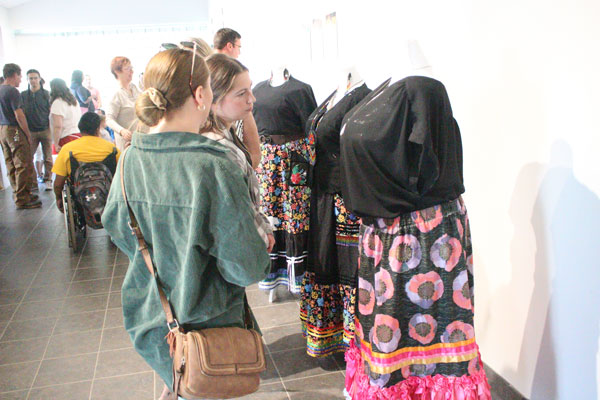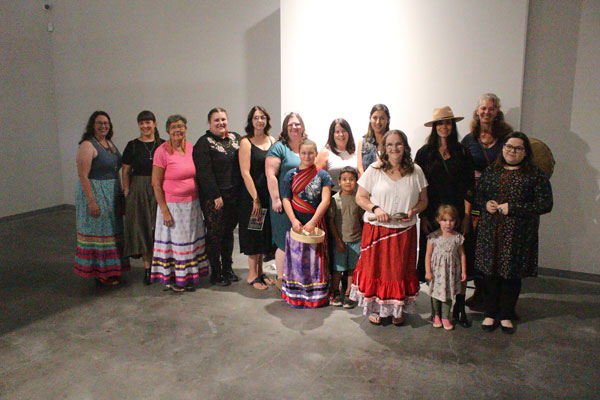
A ribbon skirt can tell the story of a life of a Métis woman, and that was the purpose behind the Love in Every Stitch: Métis Ribbon Skirts From Kistapinanihk project.
The Mann Art Gallery hosted an opening reception for the new display on Saturday. Love in Every Stitch features the tangible stories of Métis women artists currently living in Kistapinanihk (the Prince Albert region).
Through the support of lead artists Leah Marie Dorion and Bonny Johnson, all participants were educated about the historic High Plains Métis Style Ribbon Skirt pattern and teachings that served as the common framework for each of their sewing expressions.
Dorion said it’s encouraging to see so many new artists find their voice.
“Every one of these women are going to share what they learned and take it forward,” she said. “I think we really contributed to the arts community in a glorious way.”
The project sprung from a collaboration between Johnson and Dorion on a Métis Ribbon Skirts book in 2019.
“Leah had asked me if I would help her to write a book about Métis Ribbon Skirts and I was very hesitant,” Johnson remembered. “She also asked me to help do a moss bag, because I carry traditional teachings from the work I have done with the Elders for decades.”
They traveled together to a moss bag workshop at Wanusewin and there were no teachings and Dorion asked Johnson to collaborate and the book was published. Johnson said it was important to have traditional teachings carried forward.
Each of the participants were given traditional Indigenous teaching around why the ribbon skirt is worn. Meanwhile, Dorion did research and shared all of her findings in terms of colours and fabrics and history.
“We combined both and invited women to come and make a ribbon skirt to tell their story in a cultural way,” Johnson explained. “For me, that was a big motivator because it’s a healing process and we don’t get to use our voices historically. We have been very shushed.”
Johnson said the project has not only shed light on traditional Métis clothing, it’s helped participants improve their mental health.
“We all have trauma and throughout the workshops that we have done many women have come to us and had these epiphanies of what wonderful, human growing experiences has helped them to move forward through their trauma,” she explained. “I think when we are talking about truth and reconciliation as a society, we have to acknowledge those things.”
Joining Johnson and Dorion were Kay Chandler, Erin Dyck, Keeley Henry, Tanya Lemieux, and Melanie Markling, Addison McInnes, Suzanne Moran, Beige L. Unger and Erika Warkentine with Elder Liz Settee providing spiritual and emotional support for the collective. The progress made over the six weeks of the project impressed both Johnson and Dorion.

“There are a number of them who have never touched a sewing machine or a needle in their lives and when you look at the projects that they made, they are absolutely amazing,” Johnson said.
“They all had a reason for signing up for this project and we really believe there are no coincidences, so each of them was picked for a reason. It was a really strong group, (but) we didn’t know each other at first.”
Dorion said that she couldn’t think of a better project to be a part of.
“We built in so many supports that the participants could only succeed,” she explained. “We made sure that they would have success. We really kept that cultural focus. We always wanted the story of your skirt, the story of your life, the story of you in the form of a skirt. Because they were all Métis women we really, really wanted to bond them to their Métis identity and hear the story of how they have navigated their Métis identity and challenges and experiences. There was a commonality, but everyone had a unique journey.”
Dorion said that there was six weeks of drop in studio time during the summer, but many participants attended each week because it was work and also fun.
“The studio was just humming with creativity and innovation and as an artist, when you put that many creative people together with sewing machines and textiles and ribbons, the interpretations and the influence (increase),” Dorion said. “We influenced each other to be better artists. That’s a highlight for me.”
During a presentation on the project, Johnson said the group learned together and bled together.
“Someone may have had a bad day and had to share about it and we could relate and make it fun and joke about it,” Johnson said. “We all left a little lighter and a little closer, so proud of them.”
The differences among the women can also lead to finding common threads, according to Dorion.
“Even just women sewing together, there was 100 new skills added to the pot. We all learnt a new skill and even Bonny, who has sewn forever, got shown a few new twists on things that she could do. Isn’t that amazing? Everyone grew with a new skill and new perspective.”
Johnson said that a point of the project was to have women make a piece of wearable art that told their story.
“Leah’s a hustler so she went out and she made it happen. So now that I am standing here today and having this experience it is like full circle. This is exactly what I envisioned, this is exactly what I wanted and I just want to go and do it again because we have changed the lives literally of nine participants and we should all have that experience. Everyone who needs that should have it,” Johnson said.
Johnson explained that she sees being in creative space as being a way to hear the Creator’s voice.
“We may have a plan and an idea of what we are starting, but as we’re working, the Creator’s voice talks to us and we get ideas. Some people call it intuition. I have been taught that is the Creator’s voice, so it’s a very Zen, spiritual, strong experience,” Johnson said.
Johnson said that the participants had become sisters.
“It just thrills me because they are in a position where they can listen to Creator’s voice and fulfill their lives in a very meaningful way,” Johnson said.
Dorion said that along with the research she pulled the various people together and get the project going.
“That’s my gift is to pull funders, to find a recruitment process, get the Elder selected and work with the gallery. I’m more like the Métis middleman in Métis arts. I’m the entrepeneaur. I’m playing my historic role and bringing all of these different parties together to be creative,” she said.
The project is generously funded through Canada Council for the Arts and the Shushkitew Collective. Tarah Hoguesof the Shushkitew Collective was on hand and gave a speech during the introduction.
Dorion also thanked the Mann for their help.
“Mann Art Gallery creates a beautiful space for our community to be creative and without the Mann Art Gallery providing this space and this commitment we couldn’t. It would have been a little more difficult,” Dorion said.
Michael.oleksyn@paherald.sk.ca

